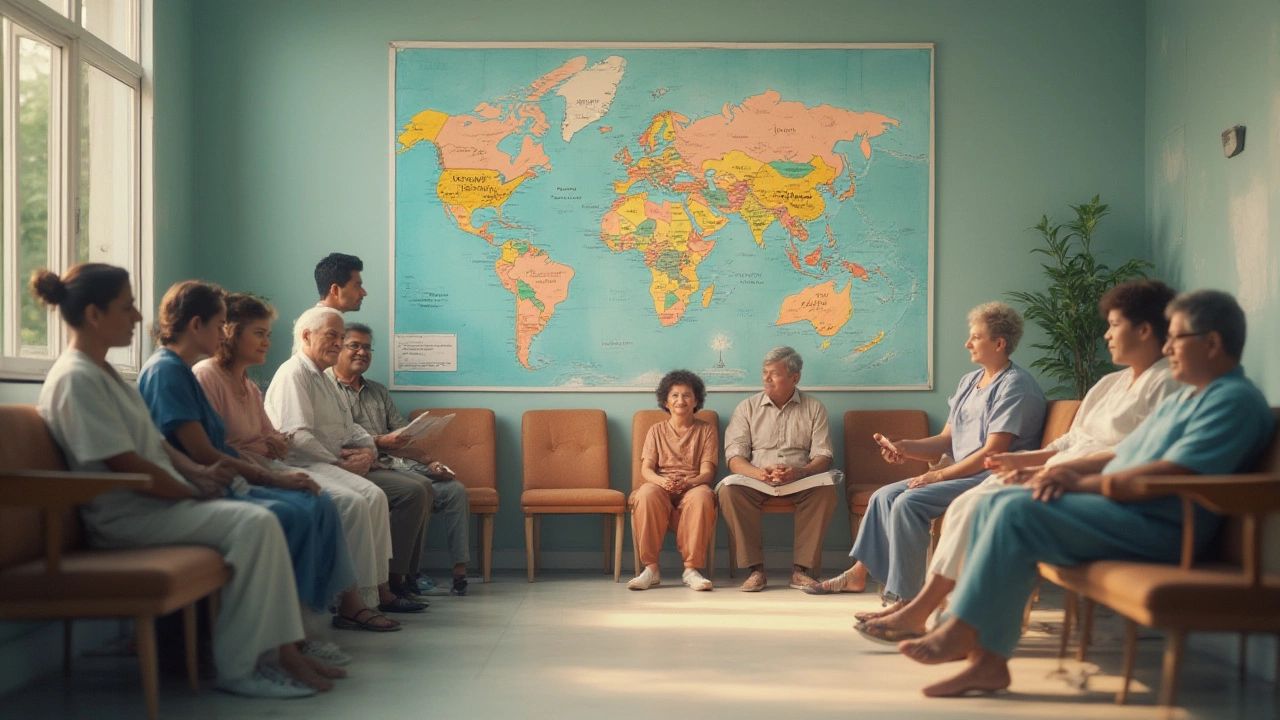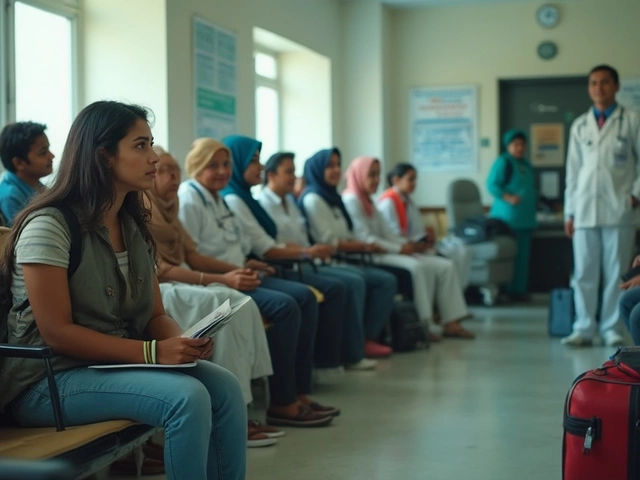
Ever tried wrapping your head around free healthcare? It sounds almost too good to be true. Walk into a hospital, see a doctor, walk out—without ever seeing a bill? For most people living in the United States, that’s the stuff of fairy tales. But here’s an interesting twist: free healthcare isn’t just a story; it’s a normal reality in a bunch of places, sometimes in countries you’ve never thought much about. And it’s not always the socialist utopias or the tiny Scandinavian experiment—some huge, busy countries have cracked the code, and their systems are filled with weird loopholes, real perks, and the occasional “wait-your-turn” grumble.
What Does Free Healthcare Really Mean?
So, what are we actually talking about when folks mention free healthcare? Most of us see the phrase and picture a magic healthcare card that unlocks endless, no-questions-asked doctor visits, hospital stays, or surgeries. But reality’s a bit messier. When people say “free healthcare,” they usually mean a system where the government takes care of the bill—think taxes covering most, if not all, medical services—so doctors and hospitals aren’t allowed to dunk you into debt just because you broke your leg or caught the flu.
Here’s the kicker: Not every country’s idea of “free” is the same. In the UK, for example, under the National Health Service (NHS), you can see your doctor, get emergency care, take an ambulance, and even undergo major surgery without a direct bill. Prescriptions are free for some, though most adults pay a flat rate that’s way less than what you’d shell out at a US pharmacy. Meanwhile, in Canada, all citizens and permanent residents get public health coverage, but you might have to pay for dental, vision, or prescription drugs unless you’ve got supplemental insurance.
France is another prime example—its universal health coverage is one of the world’s most beloved. Patients pay a small part upfront, get most of it reimbursed, and most people have extra insurance to cover the gap. Want a little trivia? 95% of French people have public coverage, and about 85% purchase private insurance to make sure absolutely everything’s handled. It turns out, even in the world of “free,” backup plans are a way of life.
But here’s a surprise: Very few countries actually give you every medical service for free. There are usually modest copays, sometimes limits on what’s included (such as elective procedures or brand-new treatments), and of course, waiting times that can push your patience. But still, the bank-breaking bills and surprise costs are almost always off the table. And once you get used to that peace of mind, it’s hard to go back.
Which Countries Really Offer Free Healthcare?
Here’s the golden question: who actually nails it? Let’s talk names. Free healthcare is almost baked into life in these countries:
- United Kingdom—The NHS covers everything from doctor’s visits to hospital stays, and even some specialty care. Sure, you might wait for non-emergencies, but if you need care in a pinch, nobody checks your bank account.
- Canada—Medicare (not the American one) covers ALL essential hospital and physician services. Yes, you’ll pay extra for things like teeth cleanings or eyeglasses, but you won’t pay a penny for surgery or emergency treatment.
- Sweden, Norway, Denmark, Finland, Iceland—The Nordics treat healthcare like they treat snow: a normal part of life everyone shares. It’s government-run, paid-for with taxes, and includes just about everything essential, often with only token co-pays.
- France—Spends a huge chunk of GDP on health (close to 12%) to make sure no one gets left behind. Low or no bills, excellent hospitals, and door-to-door home nurse care if you ever need it.
- Germany—There’s a massive public insurance fund you’re required to chip into if you’re employed. It covers about 90% of the population. The rest? Mostly self-employed or very high earners, who often buy similar private plans.
- Australia—Medicare (again, not the US one) covers all public hospital care, doctor visits, and a handful of necessary prescriptions. If you want speedy access or elective extras, you buy private insurance.
- New Zealand—Government healthcare is there for everyone, funded by taxes. GP visits and prescriptions are usually subsidized, and public hospitals provide free treatment and emergency care for residents.
Other countries with some form of universal or nearly free healthcare include Italy, Spain, Portugal, Switzerland, Austria, Belgium, Japan, South Korea, Singapore, and Estonia. Even tiny places like Cuba and Costa Rica have fully government-run healthcare systems that score highly for access and population health. Singapore stands out for blending public insurance and personal health savings accounts—locals put away part of their salary in "Medisave" accounts for routine costs, while the government steps in for big stuff.
But here’s the thing—it isn’t all roses. Sometimes, “free” means you get what you pay for…eventually. In the UK, waiting for hip surgery or a specialist can take ages, especially after COVID-19 swamped the NHS. In Canada, there have been stories of folks crossing the border to the US for faster procedures. It’s a trade-off: peace of mind versus instant access.

How Do Free Healthcare Systems Actually Work?
Let’s pull back the curtain a bit. How do these countries pay for everyone’s healthcare? The answer’s surprisingly unglamorous—taxes. Lots and lots of taxes. But instead of juggling private bills, insurance paperwork, and bankruptcies (looking at you, USA), everyone chips in a fair slice, and everyone reaps the benefits. The details, though, are really different from place to place.
Most countries manage free healthcare through one of two setups—single-payer or multi-payer systems. The UK and Canada go the single-payer route. There’s one big, government-run insurance pool. People pay income-based taxes, and the government directly pays hospitals and doctors. Healthcare providers work for the government or get reimbursed from a central fund. Sounds simple, right? (Well, on paper, anyway.)
Germany, France, and lots of European countries take a multi-payer route. Instead of one national plan, folks pay into several mandatory, government-approved insurance funds. Employers match contributions, and plans are not-for-profit. If you earn more, sometimes you can opt for private coverage, but basic care is always covered, no matter what. This setup allows a bit of consumer choice—want more perks? Pay for a spiffier plan. Happy with the basics? Stick to the public version.
Australia and New Zealand blend their systems a bit. Public hospitals and ERs are totally free, courtesy of the national or state governments, but if you’re craving faster or private treatment, supplemental insurance is available (and quite common among the middle class). The aim isn’t to force everyone into the same box but make sure nobody’s left empty-handed when life throws them a curveball.
With all these models, the government sets prices (so greedy price-gouging is rare), invests in prevention, and negotiates bulk drug costs to keep things sane. Doctors get paid less than their US counterparts but usually love their job security and work-life balance. (A buddy of mine living in Sweden claims his family doc works four days a week and still takes five weeks off every summer. Try telling that to a US resident juggling two jobs and a mountain of debt.)
And what happens if you’re an expat or a tourist? Many universal healthcare systems will still treat foreigners in emergencies, but routine care is mostly for residents. In Japan, you’re required to join the national insurance pool if you stay for more than a year. In Spain and Portugal, expats can buy into the public system or keep using private insurance. So if you’re planning a long adventure overseas, do your homework on what you’re entitled to. I learned the hard way last year when my wife, Anjali, and I managed to both get food poisoning on a trip to Lisbon. Good news: the beautiful Portuguese public hospital patched us up—bad news, we had to fill out mountains of forms and flash our travel insurance cards. Lesson learned.
Tips If You’re Headed To A Country With Free Healthcare
Thinking of moving, working, or traveling somewhere with universal healthcare? The rules vary a lot, but here are some lived-in tips that can save money, time, and gray hairs.
- Research your rights. In the EU, citizens often get cross-border coverage, but non-citizens or digital nomads may need private plans until they gain legal residency. Each country lists requirements on their government websites.
- Sign up for insurance fast. In Canada, there’s often a waiting period (three months in some provinces) before public insurance takes effect for new arrivals. Pack travel health coverage to bridge the gap.
- Carry your proof. Many systems are digital, but you usually need a local health insurance card, passport, or proof of residency to access free treatment. Misplacing these can lead to awkward (and expensive) moments at the ER.
- Know the limits. Most public coverage excludes elective cosmetic procedures, dental work, and sometimes ambulance transport or vision care. Supplemental insurance is popular for a reason.
- Don’t assume prescriptions are free. Some countries, like the UK, cap prescription costs; in others, like Germany or Japan, you pay a small copay. Keep receipts for possible reimbursement.
- Plan for wait times. Public systems often mean you’ll wait longer for specialist care or non-urgent surgeries, so if you have chronic conditions requiring regular attention, discuss your options early.
- Travel insurance is still smart. Even if you’re visiting a "free healthcare" country, being a non-resident means you’ll pay full price for non-emergencies unless you’ve got global coverage. Don’t skimp here—a bad fall skiing in Switzerland gets expensive fast.
The wild thing is, everywhere you go, the basic promise is the same: when you get sick, broke, or unlucky, you don’t get punished with debt. The details change, the paperwork’s never fun, but for hundreds of millions, free healthcare isn’t a distant dream—it’s daily life. Maybe someday, a free hospital stay won’t sound shocking, but for now, it’s a reminder there’s more than one way to run a system, and plenty of blueprints already out there if you know where to look.





Rohan Talvani
I am a manufacturing expert with over 15 years of experience in streamlining production processes and enhancing operational efficiency. My work often takes me into the technical nitty-gritty of production, but I have a keen interest in writing about medicine in India—an intersection of tradition and modern practices that captivates me. I strive to incorporate innovative approaches in everything I do, whether in my professional role or as an author. My passion for writing about health topics stems from a strong belief in knowledge sharing and its potential to bring about positive changes.
view all postsWrite a comment